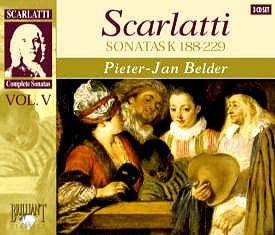There are several projects
in hand at present to record all of
Scarlatti's 555 keyboard sonatas. I
won't attempt to list them all. Perhaps
the most easily available is the series
on Naxos recorded on the piano, each
volume featuring a different and often
young player. Hearing Benjamin Frith's
light-hearted and leisurely account
of the D major Sonata K214 on Volume
5 (8.554792)
makes a fascinating comparison with
Belder. However if I did that I would
not be comparing like with like so I
will move on.
Brilliant Classics
are doing something quite unique here.
Pieter-Jan Belder is recording all the
sonatas, and although this is already
Volume five he will not complete the
project until 2007. This, like the other
sets, follows a three disc format. Each
set features a different instrument
recorded on a different date in a different
venue. This is a fascinating concept
which possibly alleviates any sense
of the sense of the routine but also
gives the instrument makers a real chance
to compare and contrast. All of this
is done at budget price.
Is this volume
worth consideration? I would say, with
just a few reservations most certainly,
yes.
I particularly appreciate
the fact that the sonatas are presented
in Ralph Kirkpatrick's ordering (although
the Schirmer edition I possess, edited
by Hashimoto, seems to be musically
identical). Other orderings are prevalent
and arguably have more veracity but
Kirkpatrick does attempt, for the most
part very successfully, to link these
brief works in pairs.
The sonatas are almost
all in binary form; normally each half
is repeated so it is especially odd
when Belder fails to do so as with the
second half of the sonata in A, K211.
To make life doubly interesting Scarlatti's
sonatas can often be considered to be
played in pairs therefore creating a
binary form within a grander scale binary
form. These pairings are often in the
same key. This is the case with the
two A minor sonatas K217 and 218 marked
Andante and then Vivo.
These couplings sometimes make for good,
complementary and contrasting major/minor
pairs as in C major/minor sonatas K225
and 226 and in D minor/major K213 and
214 - a pastoral sonata followed by
a Spanish dance. Sometimes the pairings
seem ill-matched as in the two in Eb
K192 and 193 which both of the same
length and both marked Allegro.
The two sonatas K197 and K198 are in
the more contrasting keys of B minor
and E minor and work excellently as
a pair.
Stylistically the forty-three
sonatas recorded here cover the full
range of the baroque and show how versatile
Scarlatti really was. They also demonstrate
how knowledgeable he was of other music
in Europe at that time and this despite
his self-imposed exile in a country
(Spain) which was considerably away
from the mainstream. The sound of castanets
is never too far away from Scarlatti
as in the second half of the Sonata
in B minor K227. However listening to
the Sonata in G K210 it seems very 'rococo'
almost anticipating J.C. Bach. Some
sonatas, like that in A minor K217,
remind me of Rameau, and the Sonata
in F K194, of Handel. Added to that,
the voice of the great Bach himself
seems to be almost palpably present
at times although Scarlatti hardly ever
goes in for Fugues. Imitation, especially
at the start of a work, is common. A
particularly severe example of this
is the Sonata in G minor K196.
Of course many of these
are hair-raisingly virtuosic; take K229
in Bb and K216 in E major. Some are
just plain awkward like K228 in Bb.
Others, like the C major K199, would
not tax a young pianist too much. And
all of this goes to show that in these
works there is considerable interest
and variety. In these performances these
qualities are mostly very carefully
and enjoyably realized often with aplomb
by Pieter-Jan Belder for whom any technical
difficulties do not seem to exist.
The three instruments
are much of a muchness. Volume 1 features
a 1999 instrument by Cornelius Bom after
Ruckers which for my taste was miked
too closely and has more post-resonance
than I like. Volume 2 features a harpsichord
built by Jan Kalsbeck. This is rather
short of bass. Volume 3 features another
instrument by Cornelius Bom, this time
dating from 2002, which seems ideal.
Incidentally if you
are interested in harpsichords you might
be happy to learn that the enclosed
booklet notes by Clemes Romijn are entirely
devoted to the kind of instruments Scarlatti
had available to him and for which he
composed. The famous castrato Farinelli
lived eventually in Spain and he has
left some documentation on the subject.
There are no comments whatsoever about
the music itself.
It has to be admitted
that, as might be expected, some of
the performances are a little routine
but, letís face it, some of the sonatas
can be rather routine also. Sadly the
two come together quite often as for
example in the A major sonatas K219
and K220. It may be that this set suffers
from not having any especially well-known
pieces.
If I had to pick out
favourites I would find it quite difficult,.
There is a choice between K204 and K206
in F minor and major with their eccentric
and surprising changes of time signatures.
K215 has incredibly tangy harmonies
in the second section.
I can do nothing but
recommend this set. It will appeal strongly
to anyone who has a strong interest
in Scarlatti. There is much here to
enjoy.
Gary Higginson


